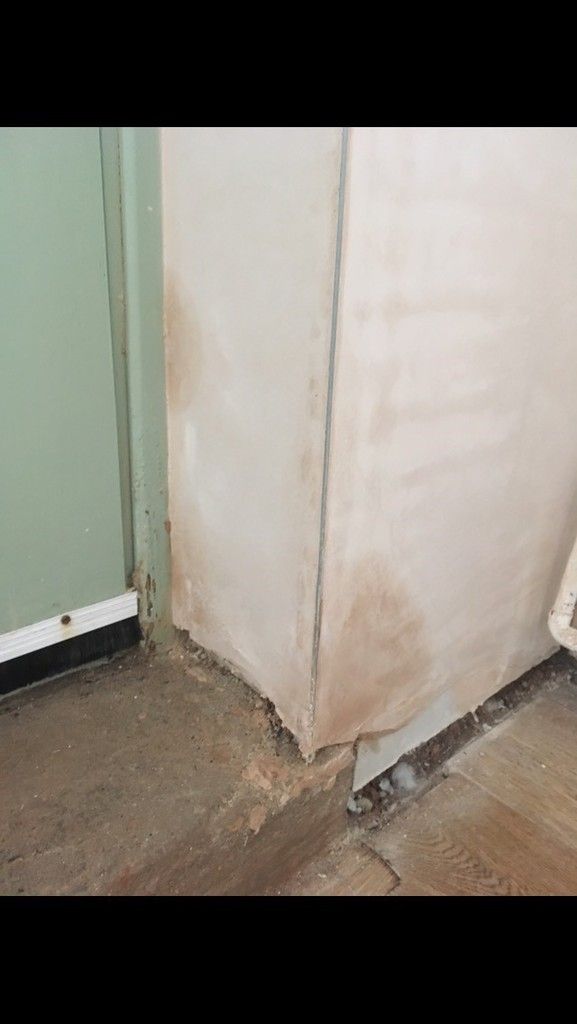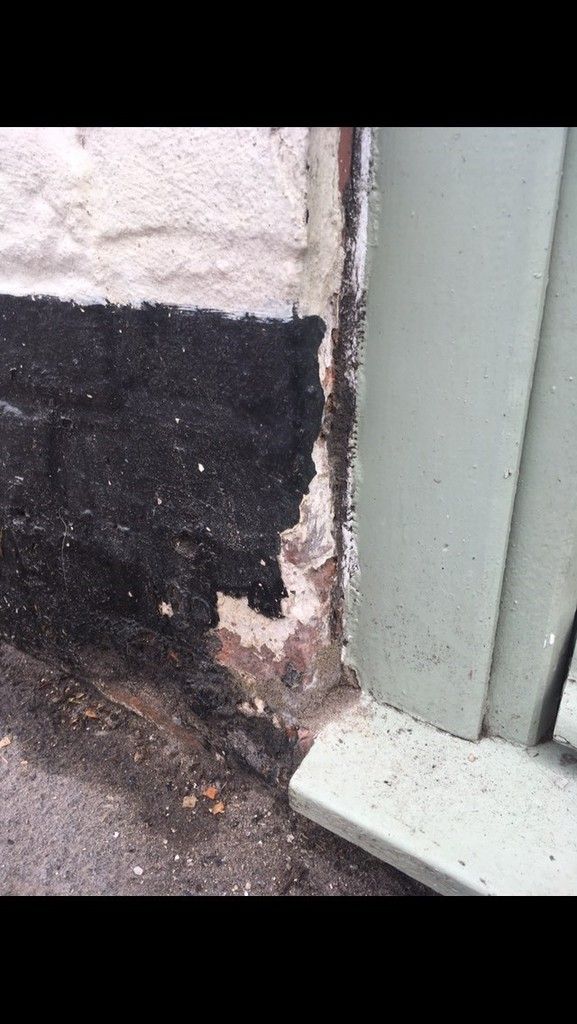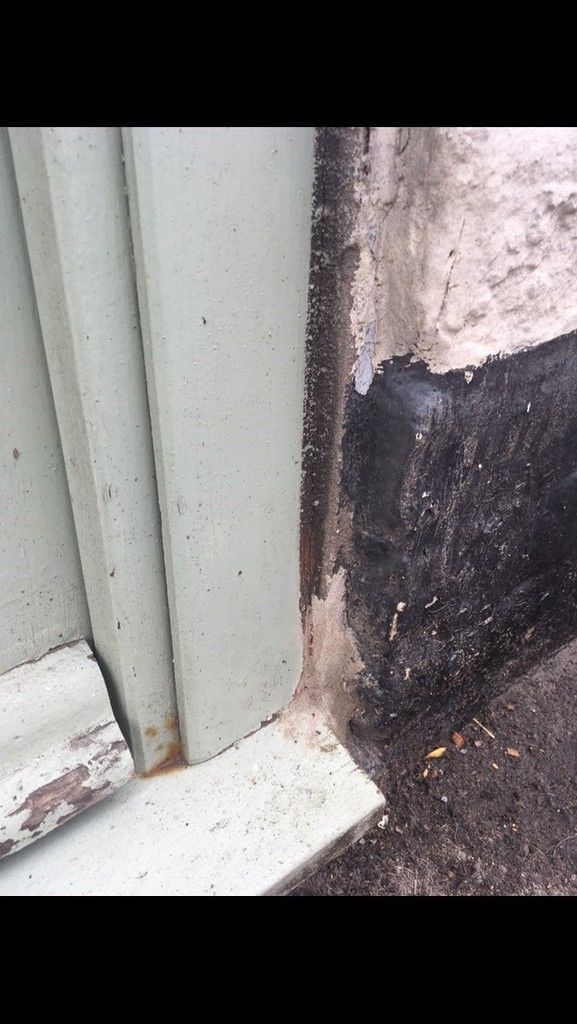We'd like to remind Forumites to please avoid political debate on the Forum... Read More »
Damp around front door - with pics
xx_lucy_xx
Posts: 174 Forumite
Water is getting through my front door frame. I have recently had some plastering work done so the wet patches stick out like a sore thumb. (It was an issue before the plastering as the paint was flaking off)
Now I was tempted to re paint externally the black paint around the bottom of the brickwork to make it watertight (from research I think its !!!!!umen paint), but from a bit more research via google, that's the wrong thing to do and the walls should breathe? Its a detached single skin rendered cottage build in 1800's
I sense the stone step may act like a sponge between outside and inside.
I just don't want to decorate and the paint get knackered again.
I did read about clay paint, has anyone had any use with this in this kind of situation?
Any advice greatly appreciated.




Now I was tempted to re paint externally the black paint around the bottom of the brickwork to make it watertight (from research I think its !!!!!umen paint), but from a bit more research via google, that's the wrong thing to do and the walls should breathe? Its a detached single skin rendered cottage build in 1800's
I sense the stone step may act like a sponge between outside and inside.
I just don't want to decorate and the paint get knackered again.
I did read about clay paint, has anyone had any use with this in this kind of situation?
Any advice greatly appreciated.




September Wins: £100 Thomas Cook Vouchers
October Wins: £500 Warehouse Shopping Spree! 
0
Comments
-
Outside is a mess.
The bricks need a few layers of paint at the very least or actually some of them replacing. Those bricks are shot and will have lost the protective layer of being fired.
You'll need sealant around the edge of the door frame externally, not mortar. Wood expands and contracts, mortar does not so you'll very quickly have gaps and it's a very likely place for water to ingress.
The plaster also could do with cutting back/up slightly inside so it isn't touching that step. Skirting boards cover that.Everything that is supposed to be in heaven is already here on earth.
0 -
Ok so when you say paint the bricks do you mean with the black bi*chumen stuff?
Got some sealant to sort round the frame, and I agree that the plaster needs cutting up so it doesn't touch. I thought about skirtings on that area but would that not just rot, is it better the wall breathes?
Thanks for your reply. First Started Comping Aug 2008 - First Aug Win 2 x Tickets To Bestival!! £260
September Wins: £100 Thomas Cook VouchersOctober Wins: £500 Warehouse Shopping Spree!
First Started Comping Aug 2008 - First Aug Win 2 x Tickets To Bestival!! £260
September Wins: £100 Thomas Cook VouchersOctober Wins: £500 Warehouse Shopping Spree! 0
0 -
Bitumen, no need for any *Tall, dark & handsome. Well two out of three ain't bad.0
-
Sounds easy fix hopefully thanks.
 First Started Comping Aug 2008 - First Aug Win 2 x Tickets To Bestival!! £260
September Wins: £100 Thomas Cook VouchersOctober Wins: £500 Warehouse Shopping Spree!
First Started Comping Aug 2008 - First Aug Win 2 x Tickets To Bestival!! £260
September Wins: £100 Thomas Cook VouchersOctober Wins: £500 Warehouse Shopping Spree! 0
0 -
xx_lucy_xx wrote: »Now I was tempted to re paint externally the black paint around the bottom of the brickwork to make it watertight (from research I think its !!!!!umen paint), but from a bit more research via google, that's the wrong thing to do and the walls should breathe? Its a detached single skin rendered cottage build in 1800's
A single skin brick wall will be around 100mm thick. Judging by your images, the wall looks to be around 200mm - This will be double thickness solid brick which would fit in with an 1800's date of construction.
You are correct in thinking bitumastic paints are the wrong sort to use on solid brick walls. As is cement render, gypsum plaster, and most modern paints. Traditionally, lime mortars & plasters would have been used along with limewash. Limewash (and clay) paints are available in a range of muted colours, but do need to be reapplied every five to ten years - One advantage of limewash is it is very easy to make your own and is dirt cheap - A bucket of lime putty for around £15, pigments to colour to taste ~£5-£10 (available from good artist suppliers and some hardware shops), and water.
A traditional sealant around window/door frames would have been made from silver sand and linseed oil mixed to a stiff paste - Once troweled in to fill the gap, itwould remain flexible and waterproof.Her courage will change the world.
Treasure the moments that you have. Savour them for as long as you can for they will never come back again.0 -
The inside step worries me because its on the same level as the outside path/road so whatever you do with it ,it will always be a damp area with no damp coarse........I would look at taking out the inside step and fitting a vertical damp coarse as it doesn't look as though there is one, it looks very damp.0
This discussion has been closed.
Confirm your email address to Create Threads and Reply

Categories
- All Categories
- 349.8K Banking & Borrowing
- 252.6K Reduce Debt & Boost Income
- 453K Spending & Discounts
- 242.7K Work, Benefits & Business
- 619.5K Mortgages, Homes & Bills
- 176.4K Life & Family
- 255.6K Travel & Transport
- 1.5M Hobbies & Leisure
- 16.1K Discuss & Feedback
- 15.1K Coronavirus Support Boards




